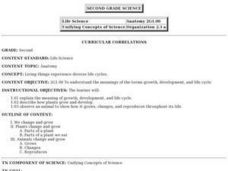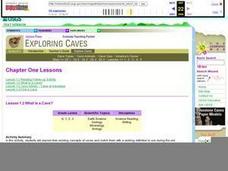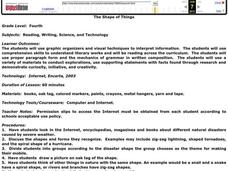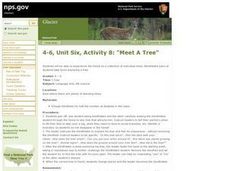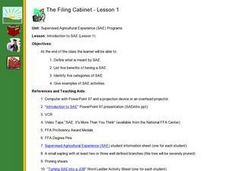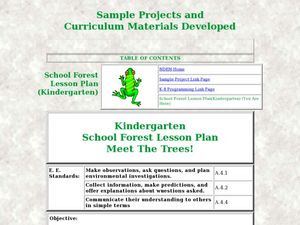Curated OER
Who is the Sea Otter Related to?
Students examine the genetic relationships of different organisms. In groups, they discover the importance of genes and how different amino acids show various evolutionary relationships. They use an online database to continue their...
Curated OER
Living Things Experience Diverse Life Cycles
Second graders will study and explain the meaning of growth, development, and life cycle. They describe how plants grow and develop and observe an animal to show how it grows, changes, and reproduces throughout its life.
Curated OER
Probability: The Study of Chance
Students conduct an experiment, determine if a game is fair, and collect data. They interpret data, then display line graph. They conduct analysis of game for probability.
Curated OER
Design a Reef!
Here is an ambitious, but highly valuable undertaking: set up a miniature coral reef in your classroom. Young marine scientists research coral reef ecosystems and ensure all vital factors are included in their functioning model. The...
Curated OER
Making & Breaking : The Rock Cycle
Students examine the rock cycle and how rocks can change over time. In this geotechnical engineering instructional activity students draw a diagram of the rock cycle.
Curated OER
What Is A Cave?
Students explore their existing concepts of caves and match them with a working definition to use during the unit. They name the two types of rock formations in which most American caves occur, and define "show cave" and "wild cave."
Curated OER
The Shape of Things
Fourth graders develop their writing skills. For this paragraph structure lesson, 4th graders research natural disasters, compile their findings, create mobiles and write stories based on the mobiles.
Curated OER
Forest Communities
Students identify tree specimens. In this tree specimens lesson, students collect different parts of a tree from the areas around the school or their home. They then work in groups to create booklet that identifies tree...
Curated OER
Mature Forest Mime
Students come to understand vocabulary words through pantomime. In this vocabulary lesson, students first review several vocabulary words and their meaning, then they work in groups to pantomime the definitions.
Curated OER
Meet A Tree
Young scholars explore different types of trees with their senses. In this nature lesson, students play a game in which pairs use their senses to explore trees, blindfolded. Young scholars then must find the tree they found when...
Curated OER
Corn Harvest
Learners read Corn Belt Harvest and write sentences about corn's uses. They visit a cornfield and a grain elevator or have guest speakers come to class. They design posters about harvesting or processing corn into grain.
Curated OER
Solid Waste Recycling
Pupils plan a "no garbage" lunch and hold a classroom contest to sort grabage into what can and what can't be recycled. They assess the importance of reducing the amount of garbage in the environment and set up a book recycling program.
Curated OER
Jackie Steals Home
Students draw on their previous studies of American history and culture as they analyze primary sources from Jackie Robinson and Other Baseball Highlights, 1860s - 1960s in American Memory. A close reading of two documents relating to...
Curated OER
The Filing Cabinet - Lesson 1
Pupils explore and define what is meant by Supervised Agricultural Experience is and list five benefits of having it. They identify five categories of Supervised Agricultural Experience and supply a wealth of examples. Each student...
Curated OER
Meet the Trees!
Young scholars investigate their school forest and make their own miniature forest. In this forest investigation lesson, students read The Giving Tree by Shel Silverstein and make alist of reasons to have trees. Young scholars...
California Academy of Science
Make your own Antelope Horns!
What are those horns for anyway? Little ones discuss the shape, texture, and purpose of horns found on animals such as the deer and antelope. They then pair up and make their own set of antelope horns to wear while visiting a local...
Curated OER
Whose Bud Are You?
Students visit an orchard and examine tree branches. They discover the buds on the branches looking for signs of life. They share their observations in their journals and with their classmates.
Curated OER
Learning About Trees
Learners identify the parts of a tree. In this earth science lesson, students draw a tree on construction paper and label the parts of the tree.
Curated OER
How Did That Get There?
High schoolers evaluate the role of government in addressing land use and other environmental issues. They analyze the powers, responsibilities, and limitations of elected and appointed officials in the national legislative, executive,...
Curated OER
Lung Disease
Students simulate breathing for a smoker and someone with a chronic lung disease. In this health science lesson, students examine the short and long term effects of smoking. They write a persuasive argument against it.
Curated OER
Pattern Using Unit Cells
Students explore the pattern of the unit cell. In this science lesson, students color the unit cells on a worksheet and create a pattern using unit cells.
Curated OER
RESPONSIBILITIES OF OFFICE
Students make an organizational chart. They show the relationship of power in the executive branch of the Illinois state government. They include the responsibilities of each office and define the roles and responsibilities of top...
Curated OER
Mighty Oaks from Little Acorns
What does it mean to grow? To germinate? For the plan detailed here, class members investigate the growth process of an oak tree while focusing on the beginning stages of planting and germination. They plant seeds and record observations...
Curated OER
Primate Primer
Students examine the different branches of the primate family tree. They create fact cards about various species of non-human primates and then write fictional skits about interactions among the different primates.
Other popular searches
- Major Branches of Science
- Biological Sciences Branches
- The Branches of Science
- 20 Branches of Science
- 12 Branches of Science
- Three Branches of Science
- All Branches of Science
- Earth Science Branches
- Biological Science Branches
- Science Branches



